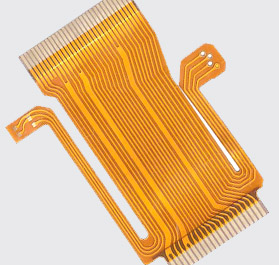Flexible PCB manufacturer:How to Make a Bendable PCB More Flexible?
How much can you bend a PCB?
FlexiblePCBmanufacturer learned the maximum bend radius for a PCB depends on the design.Some PCBs can be bent up to 20 times, while others can bend up to 20 times.Generally, it is best not to bend the circuit board more than once.For example, performing a 90-degree bend increases the chance of circuit damage.Lastly, make sure the bending radius does not exceed one millimeter.Ultimately, it depends on the type of PCB you use and the intended application.

The flexibility of a PCB depends on its thickness and construction.A thicker flexible stackup will require a larger bending radius to avoid brittleness.It will also reduce stress along the bend.On the other hand, a small bend radius could result in a bunching of the coverlay inside the bend, causing more shear stress on the circuit.Therefore, we make flexible circuit boards from a copper-coated film.
You can bend PCBs up to 180 degrees with a flex material.However, if you try to bend it past its recommended limits, you could end up destroying your circuit board.This would be a costly mistake.
Applications of Bendable PCB
Unlike the traditional PCB, it is possible to design a bendable PCB with a thin and flexible base material.The base material and its adhesive determine the thickness of the flex circuit.The base material is usually a plastic or paper.However, a polyimide film with a higher heat resistance and bending strength is an alternative.The stiffener, usually a steel sheet, acts as a support structure.

A flexible PCB’s core is made of a PI substrate, which can be transparent, yellow, or black.The flex circuit layers consist of etched copper foils you can often roll to increase ductility and repeatable bending ability.The copper layers are insulated by PI layers, equivalent to the solder mask on the normal PCB.A rolled copper foil will allow a higher line width than a bare copper PCB, increasing the board’s flexibility.
Another advantage of bendable PCBs is their ability to reduce the size and cost of the product.Unlike rigid PCBs, flexible PCBs are typically 10 percent less than a traditional FR-4 PCB.In addition to a lower cost, we can assemble bendable PCBs in less space than their rigid counterparts and have a much higher reliability rating.The flex PCB material also has an excellent bend resistance and is common in flexible electronics.
You will find flex PCBs in mobile devices. For example, some smartphones have flexible screens that can roll or bend. In addition, these devices are often water-resistant, making it necessary for a flexible PCB to function well. Flexible PCBs are also essential for medical and pharmaceutical applications, where the board must survive extreme conditions inside the human body. It makes them ideal for devices like pacemakers, insulin pumps, and medical devices.
Why not use bendable PCB all the time?
A flex circuit board is versatile in that you can bend at various angles. Because it’s able to bend, it makes it easier to install and remove. But if you’re concerned about its bendability, you should know a few things before you make a purchase.
Unlike traditional circuit boards, FPC are resistant to extreme temperatures. Temperatures can range from 200 to 400 degrees Celsius, making them an ideal choice for high-temperature, high-density applications. They’re also resistant to radiation, UV exposure, and chemical reactions. As a result, it makes them an ideal choice for various industries, including oil and gas, automotive, and aerospace.

Other news about S&L
- Sun&Lynn Circuits CO., Ltd. was invited to attend the Sixth Global Customs AEO Conference!
- Celebrating the Establishment of SUNLYNN CIRCUITS(THAILAND)
- Good News! Sun&Lynn Circuits Co.,Ltd. is honored as one of the Top 100 Innovative Enterprises in Bao
- What Should You Know about Metal Core PCB
- FPC supplier : the types of Flexible PCB
- PCB manufacturer China:Why PCB board snake line, what is it used for?
- What is Metal Core PCB and types of Metal Core PCB?
- Why are High frequency PCBs much more expensive than normal PCBs?
- Flexible PCB supplier China :When to use flexible PCB?
- Flexible PCB manufacturer:What Is Flex Soldering?
Your browsing history
- Rigid-Flex PCBs Fabrication Applications
- S&L Circuits Flex rigid PCB manufacturer has been awarded the National Intellectual Property Managem
- Heavy copper PCB Boards exhibit a high tolerance capacity
- FPC Manufacturer Introduce To You What FPC Is And It`s Manufacturing Process
- PCB supplier china tells you What is MCPCB
- PCB factory china:Double-Sided & Multi-Layer Flex PCBs
- Why are High frequency PCBs much more expensive than normal PCBs?
- DES line
- Flexible PCB manufacturer:Why Did Flex PCB Come into Play?
- Cost Benefits to Rigid-Flex PCB



A total of -comments【I want to comment】